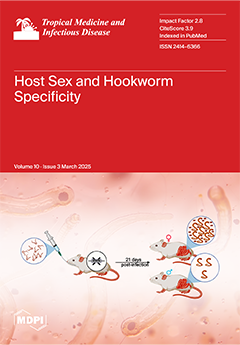Open AccessArticle
The Etiology and Antimicrobial Susceptibility of Community-Onset Urinary Tract Infections in a Low-Resource/High-Resistance Area of Latin America
by
Maria Micieli, Selene Rebecca Boncompagni, Tiziana Di Maggio, Yenny Bertha Mamani Ramos, Antonia Mantella, Ana Liz Villagrán, Carmen Angélica Revollo Yelma, Evelin Esther Fortún Fernández, Michele Spinicci, Marianne Strohmeyer, Lucia Pallecchi, Gian Maria Rossolini and Alessandro Bartoloni
Viewed by 1212
Abstract
Urinary tract infections (UTIs) are common and are typically treated empirically, based on local antimicrobial resistance (AMR) data, which are often scarce in low- and middle-income countries. This study examines the AMR patterns of pathogens causing community-onset (CO) UTIs in the Bolivian Chaco.
[...] Read more.
Urinary tract infections (UTIs) are common and are typically treated empirically, based on local antimicrobial resistance (AMR) data, which are often scarce in low- and middle-income countries. This study examines the AMR patterns of pathogens causing community-onset (CO) UTIs in the Bolivian Chaco. Urine samples were collected from subjects with suspected CO-UTIs and analyzed by culture techniques. Significant isolates were tested for their antimicrobial susceptibility. Additionally,
blaCTX-M and
mcr genes were searched for using real-time PCR. A total of 361 CO-UTI episodes were diagnosed among 731 subjects from February 2020 to November 2021. The cases included uncomplicated and complicated UTIs (58.2% and 41.8%, respectively), with females accounting for the majority (85.3%) of cases.
Escherichia coli was the most prevalent pathogen (86.6%), followed by
Klebsiella pneumoniae (5.4%) and
Proteus spp. (2.2%). Very high resistance rates (>50%) were observed for ampicillin, trimethoprim–sulfamethoxazole and fluoroquinolones, high resistance rates (>20%) for amoxicillin–clavulanate, third-generation cephalosporins and gentamicin, while lower resistance rates (<10%) were observed for nitrofurantoin and fosfomycin. The prevalence of
blaCTX-M among
E. coli was high (26.7%). Colistin resistance was detected in 3.4% of
E. coli, mostly associated with
mcr genes. CO-UTIs from this area were characterized by high resistance rates to commonly used antibiotics (trimethoprim–sulfamethoxazole, amoxicillin–clavulanic acid and ciprofloxacin), highlighting the importance of knowledge of the local epidemiology to inform the selection of appropriate empirical antibiotic regimens.
Full article
►▼
Show Figures






